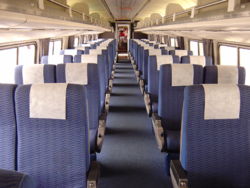Silver Meteor
The Silver Meteor is a 1389-mile (2235 km) passenger train route operated by Amtrak in the Silver Service brand, running from New York City south to Miami, Florida via the Northeast Corridor to Washington, DC, then via Richmond, Virginia, Fayetteville, North Carolina, Charleston, South Carolina, Savannah, Georgia, Jacksonville, Florida and Orlando, Florida.
The Silver Meteor shares much of its track with the Silver Star, which runs further west through North Carolina and South Carolina and detours to serve Tampa, Florida. The Palmetto uses the same tracks as the Silver Meteor for its whole length, terminating in Savannah, Georgia.
History
The Silver Meteor was originally a train of the Seaboard Air Line Railroad (SAL), placed in service on February 2, 1939.[1] The train was operated between New York, NY, and Washington, DC, by the Pennsylvania Railroad under a haulage agreement. Between Washington and Richmond, it used the tracks of the Richmond, Fredericksburg and Potomac Railroad, jointly owned by the SAL and five other railroads for the use of all. From Richmond south the SAL's own trackage was used, running via Raleigh, North Carolina, Columbia, South Carolina, Savannah, Georgia, Jacksonville, Florida and Ocala, Florida. Until the late 1960s, the Silver Meteor split at Wildwood, Florida, with one section continuing to Miami, Florida and the other serving St. Petersburg and Sarasota-Venice on Florida's west coast.
The SAL merged with the Atlantic Coast Line Railroad to form the Seaboard Coast Line Railroad in 1967, and on May 28, 1968 the Silver Meteor began serving only Miami (the similarly-routed Silver Star then served only St. Petersburg). Amtrak continued to operate the Silver Meteor when it took over operations on May 1, 1971; on November 14 the numbers 83 (southbound) and 84 (northbound) were assigned.
From December 17, 1971 to April 15, 1972 and September 10, 1972 to April 27, 1973, the Silver Meteor bypassed Jacksonville, running over the track between the Georgia state line and Baldwin, Florida. Between June 11 and September 10, 1972, the Silver Meteor was extended to Boston and called the Meteor. From June 11 to December 15, 1972, a separate section to St. Petersburg was added.
On September 30, 1979 the Silver Meteor was rerouted between Savannah and Jacksonville over the former Atlantic Coast Line Railroad route, due to the abandonment of the old SAL route. On January 31, 1984, the Silver Meteor's Florida west coast terminus was cut back from St. Petersburg to Tampa , thus ending almost 100 years of rail passenger service to St. Petersburg. By October 26, 1986, the Silver Meteor had shifted to the old ACL route north of Savannah, as the abandonment of the SAL route north of Raleigh affected only the Silver Star. On June 11, 1988 the tracks between Coleman and Auburndale, Florida were abandoned, shifting the Miami section west to Lakeland.
By the end of 1988, the numbers assigned were 87 and 88 (to Tampa) and 97 and 98 (to Miami). The Tampa trips were later dropped, and 97 and 98 are still used.
Route details
The Silver Meteor operates over Amtrak and CSX Transportation trackage:
- Amtrak Northeast Corridor, New York to Washington
- CSX Landover Subdivision, RF&P Subdivision, Richmond Terminal Subdivision, North End Subdivision, South End Subdivision, Charleston Subdivision, Savannah Subdivision, Nahunta Subdivision, Jacksonville Terminal Subdivision, Sanford Subdivision, Auburndale Subdivision, and Miami Subdivision, Washington to Miami
Station stops
The Silver Meteor, trains 97 southbound and 98 northbound, makes the following station stops:
- Jacksonville
- Palatka
- DeLand
- Winter Park
- Orlando
- Kissimmee
- Winter Haven
- Sebring
- West Palm Beach
- Delray Beach
- Deerfield Beach
- Fort Lauderdale
- Hollywood
- Miami
External links
References
- Mike Schafer, Amtrak's atlas, Trains June 1991
- PRR Chronology
- Amtrak's First Trains and Routes
- Amtrak timetable, November 14, 1971
- Amtrak timetable, late 1988 (Northeast Corridor only)
- ↑ Stainless Steel Passenger Car, ex-Seaboard, Silver Meteor #6200. Pacific Northwest Chapter of the National Railway Historical Society.

